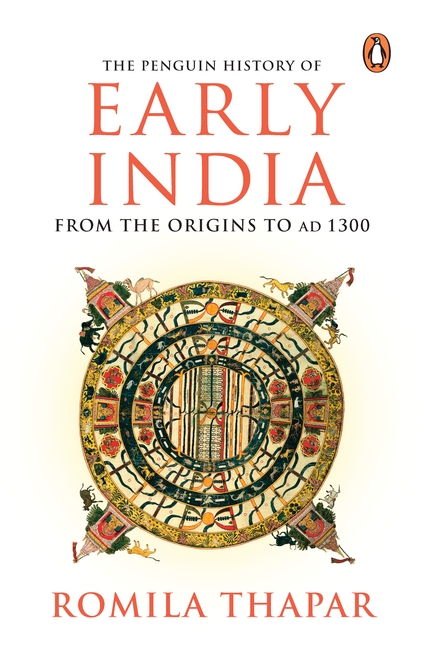Review of Early India – from the origins to AD 1300 by Romila Thapar
Review of Early India – from the origins to AD 1300 by Romila Thapar
Romila Thapar is a professional zealous historian and is an authority on Indian History. I read the fourth and latest edition 2021. A layman often gets curious about history when politicians come out with very creative distortions of the history, culture and pride of a particular caste, religion or race. The whole world has nothing to be proud of or to celebrate when we look at the accumulation of arms, the exploitation of the socially and economically marginalized and the irreparable damage done by all the generations to ecology. Still the politicians howl and snarl and cross swords with the opponents citing creative texts or religious books and unverifiable claims about the ‘golden era’ of the land or invasions of alien culture forces from time to time. Since the Indian subcontinent has millennia of history just like the counterparts China and Eurasia, her history offers plenty of scope for motivated mischief. As many of us have seen from time to time German history shows how a racist hatched and gruesomely carried out a genocide about a century back. In India the vote bank politics during elections in various states and the parliament has given the most absurd version of India’s past. The ‘Aryan’ / Dravidian races and their origin and supremacy have been distorted so much in Tamil Nadu / National politics, that it will be very difficult for a common man to gauge whether his identity is so vulnerable and fragile. The scientific research, nevertheless gives a picture that exposes the false claims of the political masterminds. I reproduce a part of my earlier post on this below:
I would cite this portion of the article which makes it very clear that we are multi-ethnic for many millennial with the exception of Andaman and Nicobar Islands tribe:
"So far, we have only looked at the migrations of Indo-European language speakers because that has been the most debated and argued about historical events. But one must not lose the bigger picture: R1a lineages form only about 17.5 % of Indian male lineage, and an even smaller percentage of the female lineage. The vast majority of Indians owe their ancestry mostly to people from other migrations, starting with the original Out of Africa migrations of around 55,000 to 65,000 years ago, or the farming-related migrations from West Asia that probably occurred in multiple waves after 10,000 B.C., or the migrations of Austro-Asiatic speakers such as the Munda from East Asia the dating of which is yet to determined, and the migrations of Tibeto-Burman speakers such as the Garo again from east Asia, the dating of which is also yet to be determined. What is abundantly clear is that we are a multi-source civilization, not a single-source one, drawing its cultural impulses, its tradition and practices from a variety of lineages and migration histories." (Link for the article: https://www.thehindu.com/sci-tech/science/how-genetics-is-settling-the-aryan-migration-debate/article19090301.ece)
The above finding of the research must be read with the stand of Romila in this book on the Aryan issue:
(page 14)
“By the mid twentieth century, the notion that language and race can be equated was found to be invalid, and indeed the entire construction of unitary races was seriously doubted. The concept of an Aryan race fell apart. Race is essentially a social construct, although initially it was claimed to be based on biology. Recent genetic studies have further invalidated this claim. It is therefore more correct to refer to ‘the Indo-Aryan speaking peoples’ than to ‘the Aryans’, although the latter term can be used as shorthand. It is important to emphasize that it refers to a language group and not to race, and language groups can incorporate a variety of people.”
The author in pages 105-109 gives her typical scientific analysis of how ‘Avesta’ of Iran was the language of the Indo-Aryan languages. Both Avesta and the Indo-Aryan languages had the same ancestral language. History is probably the most important part of social science because of the significance of the importance attached to it by all generations. The right wing in India had every reason to target Romila as a left oriented historian and they wouldn't buy any of her findings. But time and again she has mentioned in several interviews that there are internationally followed and professionally acclaimed standards of understanding history based on the (however limited may these be) excavated artefacts, monumental constructions and the proofs found at various historically important sites that give an account of the life at that place dating back to a specific century in a specific millennium. We all know that carbon dating is a scientific method found authentic and used both by historians and the police in forensics.
An average voter certainly falls prey to the most colourful and proud picture of his forefathers. No wonder politicians and historians are poles apart. Nonetheless, the evidence collected and analysed by the historians on the earliest eras of India and Eurasia are insufficient and Romila repetitively mentions in the book, there is need and scope for more excavations in the Indian subcontinent. Still, a historian has to go with the available material and do justice professionally and carefully. The book is very voluminous and Indian history is full of wars between various kingdoms and the power struggle in each. The ascendance to power or the leverage to change the power equations was available only to the upper caste and over the millennia of Indian history only one thing remained unchanged, that is , obviously the role of ‘Varnasrama Dharma’ favouring the upper caste. The font was very small, and I managed to complete the book because of my quest to get closer to the truth about India and her history.

Comments
Post a Comment